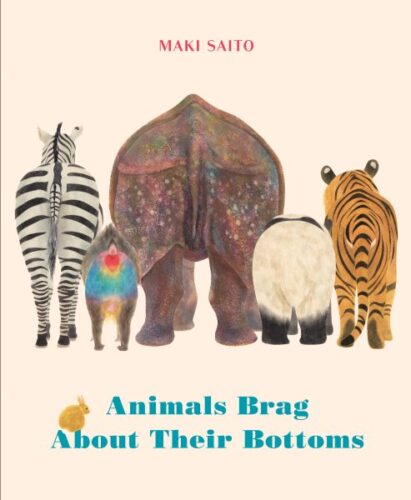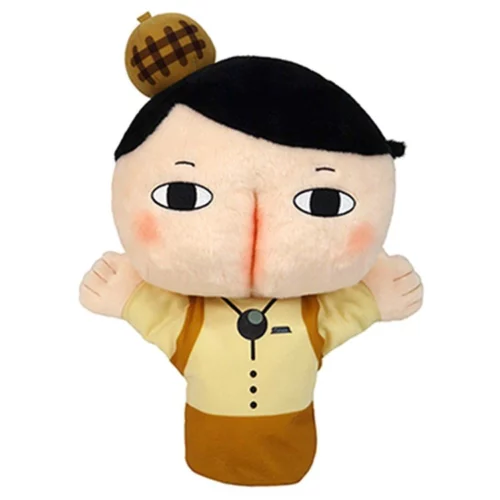A Super Serious Discussion with Sue Conolly. Filled With Butts.
A couple weeks ago I had the chance to go to the Bologna Children’s Book Fair. It was neat. I wrote many fun posts on the topic. I posted many images to Instagram and Twitter and Facebook. But without a doubt, there was one particular image that captured the hearts and minds of my readers and followers more than any other.
Prepare yourself:

Yep. You read that right. The Butt Detective. Unfamiliar with the series? That indicates that you may be an American. We live in a country where we’ve a very tenuous connection to children’s books that involve the body and bodily functions. Nudity of any sort makes us wildly uncomfortable. As such, all around the world people have enjoyed The Butt Detective and his misadventures for years.
ADVERTISEMENT
ADVERTISEMENT
And because she loves me, my great and good friend Sue Conolly, actually got me my very own copy! Can you believe it?
No good deed goes unpunished, they say. They are right, because once I saw this book firsthand I knew I needed to get a perspective from someone outside of the continental U.S. to talk to me about it. And Sue? She’s the perfect person to do so, as you will see.
Betsy Bird: Hello, Sue! Thank you so much, not just for talking with me today, but for giving me my very own copy of The Butt Detective too! Could you just give us a rundown of where you are, what you do, and your magnificent history with children’s literature?
Sue Conolly: I’m currently in Nagoya, Japan, teaching in the grade 3/4 pods in Nagoya International School and contributing to the library program. I’ve worked in the libraries of two Tokyo Schools, which I’ll tell you more about later and before that, I lived in Illinois where I worked with the multilingual collection of the Center for Teaching Through Children’s Books, and served for two years on the Notable Children’s Recordings Committee. As you can imagine, my special interests in children’s literature include but are not limited to: international picture books, audiobooks (and in particular picture book audiobooks), and bilingual picture books (as well as wordless books which are like the ultimate multilingual text!).
BB: What an amazing coincidence. I have the same interests! And over the years you have sent me some real prize gems, unavailable in the U.S., but available in other parts of the world. Most recently you sent me the choicest plum of them all, The Butt Detective (first in the series, yes?). Could you tell folks who are unfamiliar with this massive worldwide (except in the U.S. hit) what it is?

SC: Butt Detective – Oshiri Tantei in Japanese – is exactly as it sounds. A jauntily dressed bottom, reminiscent of Sherlock Holmes (with his poo-coloured sidekick Brown, who is a Maltese) solves crimes and knocks criminals out with his smelly farts until the handcuffs come out. He likes sweet potatoes (obviously, for professional reasons), and has an IQ of 1104, which when you translate the numbers back into Japanese is a homonym for “Good Butt”. The books are extremely popular and come out in three forms – hard-cover graphic novel, soft-cover manga and hard cover picture books. A feature of the hard cover graphic novels is the intense amount of information or “clues” provided on the reverse side of the dust jacket. When I worked at the International School of the Sacred Heart in Tokyo, these were the most popular checkout of all the Japanese language books, highlighting one major problem. We would very carefully cover the books with plastic, only to have the sticky tape peeled off so that the reader could get all of the secret clues. Every. Single. Time.
BB: The librarian in me shivers to think of the poor librarians trying to keep that mylar on the books. Of course here in America a vice-principal was recently fired for reading aloud the comparatively tame picture book I Need a New Butt. But I’m not going to lie. As an American my first knee-jerk reaction upon seeing The Butt Detective was one of shock. Since you’re not living in the States, do you still find that you have a similar American reaction to some things you encounter, or does that ebb away as you adapt?

SC: Were you surprised to learn that a very old and respected Catholic Girls School (mentioned above) loves this popular checkout so much that librarians are willing to fix the sticky tape time and time again so that students can continue to borrow this title? I was! This was my introduction to this title, but my colleague at this school who was also the father of a tweenager and the husband of a professor in Japanese literature assured me that both he and his wife were converts to this smelly crime-buster series for its clever plot twists, attention to detail and complexity of the stories following the many clues hidden under the dust jacket. It’s not just potty humour! Children seem very bottom-literate in this country, from non-fiction titles such as Gomi Taro’s “Everybody Poops” and Maki Sato’s “Animals Brag about their Bottoms” to fictional titles such as the 90s “Crayon Shin-Chan” series in which the main protagonist keeps mooning people, and a more recent picture book “Oshiri Biyori” (Butt Weather) in which all clouds are shaped like different animal bottoms and rain different kinds of poo. Don’t forget your umbrella!
I don’t have an “American” reaction to any of this, for one because I am Australian, and secondly because I have lived in Japan for a very long time and seen a lot of bottoms, as well as exposing my own in one of the many bath houses and hot springs all over Japan. I note with interest that the title you mention above “I Need a New Butt” was originally published as “I Need a New Bum” in New Zealand by a New Zealander, and this does not surprise me one little bit. After all, where I am from in Australia, Andy Griffiths has written “The Day my Bum went Psycho”, “What Buttosaur is That?”, “Zombie Bums from Uranus” and “Bummageddon – the Final Pongflict”. I’m pretty sure that American children are far more familiar with his “13 Storey Treehouse” series – perhaps as the titles are not so “on the nose” (pun intended).
BB: Oh yeah. Though I do know that The Day My Butt Went Psycho was translated here in the States as well. This next one is a bit of an unfair question to ask, since I’m not sure the answer is all that simple, but do you have any theories as to why the U.S. is so comparatively puritanical when it comes to our children’s literature? I love to hear prevailing theories.

SC: It’s definitely not a fair question to ask since I am not American so anything I say might sound preachy – but I do wonder if America’s puritanical past has something to do with its puritanical present. That’s a lot of Ps (pee-pees?) just to say, that maybe all of the different Christian influences in American history are behind this anti-bottom sentiment. To be honest, however, I’m not so sure that bottoms and poop are inherently taboo. I think they are funny to children because they are learning to poop appropriately and it’s gross and yucky and fun to laugh about, but I’m not sure what is so bad about something that literally everyone in the world must repeatedly do.
BB: Mmm. Wise words. Out of curiosity, are there other books and series that you’ve seen that you know could never get published in the States?
SC: Actually I think most of the titles I’ve listed *have* been published in the USA, Crayon Shin-Chan as a cartoon series for TV and books such as “Zombie Bums from Uranus” appropriately re-titled “Zombie Butts in Uranus”. Didn’t I see a picture from your trip to Bologna with a “Butt Detective” display with books in 16 languages? I would be interested to ask *you* in return – do you think no library will buy this book? Or public libraries, but no school libraries? Do you think you could find it in a big box book store? Independent book store? I’m really curious now, and I’m most curious about that dust jacket and those hidden clues, so I hope you can provide me with an answer! I will also add here that although I’ve worked in 3 school libraries in Japan, only 1 of the 3 stocked this series. I will also add that it was not available at the Japanese School library in Chicago when I helped out there on a Saturday. So it would seem that this title is still a hard sell for many school librarians.
ADVERTISEMENT
ADVERTISEMENT
I reached out to a couple of fellow librarians in Japan for my reBUTTal to your question about dust jackets, and I am CCing Viki Radford from Yokohama International School and Richie Steven from British School Tokyo on their own copied and pasted responses to this question. Both are excellent librarians at excellent schools, so you know that if they have Oshiri Tantei in their library two things must be true: they must not get a bunch of pushback from administration or parents, and they must have great circulation stats in their Japanese section!
Yokohama International School had this to say:
We have the Oshiri Tantei series in our Japanese library, and they are never on the shelves: constantly checked out by students. We acquired them a couple of years ago at a parent’s request. My understanding is that far from being controversial here, they are the number one children’s fiction series in Japan!Usually with tricky dust jackets I either remove them or attach them using sticky plastic.
British School Tokyo had this to say:
We have Oshiri Tantei in our collection both as picture books and as novels. Both are extremely popular and all out on loan the whole time. We have the whole lot of them. The children love them and the Japanese parents are over the moon that their children want to read them. I cannot see what possible problem there would be. He is just a bum detective but then I am a Swede that could never live in Florida.We love Andy Griffiths and Terry Denton and his Bum books. We love Aussie humour too. I frequently read out aloud to classes from his books and the children always ask for more. Andy Griffiths and Terry Denton studied and watched reluctant readers flipping through books in Coles and designed their books to capture these children’s imagination. They get some people to read books that otherwise never would.The covers from Oshiri Tantei, Kaiketsuzorori and a Japanese book that links toilets to Japanese geography, we used to cover separately and then attach them at one side to the book. This was a major job that my former library assistant did. It was a huge job the required real love and dedication plus needed constant mending. We do not do that any more as we do not really have enough time. I now just give them away so that they are not wasted.I have this to say:I no longer work at a school that has this series on the shelves. Our former Japanese librarian was a dear older lady, and I’m sure she probably didn’t feel these were quite appropriate for a school library. My former colleague from another school that didn’t have them is also Japanese and has been a professional school librarian for her entire career, and I am pretty sure she would say that as a popular book in bookstores, she didn’t feel the need to purchase them with school money.However when I did work at the school where I first met this series, we covered the dust jacket in clear plastic, sealed that pretty well, then when we taped it to the book we just used one or two pieces of tape. This was against everything I know as a librarian to allow students to rip off the cover and then put their own sticky tape in place of mine, but actually this wasn’t a terrible system. I’m sure those covers never survived the long haul though – three years later they have probably been binned.Can I also give a shout out to a Japanese picture book that I am considering for Sakura Medal nomination just because it’s so freaking weird (yes, wierder than Butt Detective). It is related in a way to Maki Saito’s non-fiction picture book “Animals Brag About Their Bottoms” (also nominated to Sakura Medal last year) in that it features the bottoms of many animals, but unlike Saito’s this one is definitely fiction and very, very strange. It’s called “Oshiri Biyori” (Bum Weather) and is about a day when all the clouds were shaped like animal bottoms. Ken’s parents warned him to take an umbrella which was lucky, because the fluffy rabbit bottom started hailing poo pellets……… Really these books are not intended to be inappropriate or have people in shock, they are really just funny ways of looking at the world. It’s pretty clever that Oshiri Tantei knocks the criminal out with a swift SBD. What child hasn’t looked at a cloud and seen a bunny bottom? Why should we listen to our parents when they say we should take an umbrella? These are the big questions in life.
Betsy, I hope that we have been able to help you get to the bottom of this important issue.
BB: I see what you did there. And taking all this into account, I think some libraries would buy this book series, but this probably applies more to public libraries rather than school (as you say). Who wants to be the librarian facing down the irate parent that’s flipping out that a book dares to show a butt with a personality? On that note, and on the flipside, are there books from America that could never be published overseas?
SC: I thought long and hard about this question. Do you know how many books come out of America every year? It is completely impossible for Japanese publishers to even publish a decent percentage of them, so many books I would *love* to see translated in Japanese just are not, for no good reason. For example, I dearly wish that Dan Santat’s “After the Fall” would come to the Japanese market but it has not (to my knowledge), even though “The Adventures of Beekle” was translated by Japan’s most famous poet, Shuntaro Tanikawa. Why would one book get the royal treatment and then the very next book be completely overlooked? I can only think that the Caldecott medal had a big part in that – but it’s truly a shame that a book that gently teaches children about anxiety and provides strategies for not giving up, never got published. However, I can’t for the life of me think of a kind of American book that would be “boycotted” in the same way that “butt books” may be in the United States. For example, rhyming books might be really hard to translate into Japanese, but I’m willing to bet that Dr Seuss’s more famous titles got the royal treatment back in the day. Just today I found an old throwback – one of the books published by Dr Seuss in the 1940s – those lengthy hard-to-read fantastical tales that pre-date Cat in the Hat which came out as a response to John Hersey’s 1954 article “Why Do Students Bog Down on the First R“
BB: And why can’t Johnny read? All right. Final question: What are you reading right now?
SC: Oh my gosh, so many things! The most fun I am having right now is putting together a list of picture books in English for the Itabashi City Library and an event they are having in September. Lots of Japanese people like to read picture books in English as a way of improving their vocabulary and international outlook, so I have had a whole world of fun putting a list together which is both diverse from a point of view of country of origin, but also in book format. I’ve got rhyming board books and lift-the-flap books, fiction and non-fiction, one book that is illustrated by 33 different illustrators, and two translated titles. I’ll send you my list if you send me yours!!!!!!!
BB: Deal!
A thousand thanks to Sue Conolly for her insights and thoughts!
Filed under: Uncategorized
About Betsy Bird
Betsy Bird is currently the Collection Development Manager of the Evanston Public Library system and a former Materials Specialist for New York Public Library. She has served on Newbery, written for Horn Book, and has done other lovely little things that she'd love to tell you about but that she's sure you'd find more interesting to hear of in person. Her opinions are her own and do not reflect those of EPL, SLJ, or any of the other acronyms you might be able to name. Follow her on Twitter: @fuseeight.
ADVERTISEMENT
ADVERTISEMENT
SLJ Blog Network
Magda, Intergalactic Chef: The Big Tournament | Exclusive Preview
Fifteen early Mock Newbery 2026 Contenders
When Book Bans are a Form of Discrimination, What is the Path to Justice?
ADVERTISEMENT








Love this piece! Former Nagoya dweller!
For those seeking them in English, EVERYONE POOPS by Taro Gomi was translated by Amanda Mayer Stinchecum and published by Kane/Miller (2001); ANIMALS BRAG ABOUT THEIR BOTTOMS by Maki Saito was translated by Brian Bergstrom for Greystone Kids (2020).
An interview with one of the many Stateside fans of Shuntaro Tanikawa, Poets.org creator Bruno Navasky, recently went live here: https://www.full-stop.net/2022/04/19/interviews/deborah-iwabuchi/bruno-navasky/
(No butts in the interview, alas!)
Cool! Thank you!